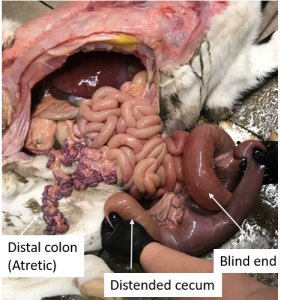FA GI Topics
Colon and rectal disorders
Calves may be born with colonic atresia. Colonic atresia has been associated with early pregnancy palpation and as an genetic anomaly in Holsteins. Most of these cases involve a large gap between the proximal end of the colon and the part attached to the rectum. Calves will present at 1-2 days of age with abdominal distension. No manure will be present in the rectum. As it is easy to perforate the distal segment, diagnosis is usually made by exploratory laparotomy or based on clinical signs. In many cases, calves have peritonitis at the time of diagnosis.

In some calves, the ends will not reach and anastomosis is not possible. In others, anastomosis can be done but motility never recovers. The latest recommendation is to perform a colostomy to enable to the calf to reach market weight.
Modified colostomy technique for colonic atresia in calves, Vet Surgery 39(6):722-728, 2010
Other colon disorders include luminal or extraluminal obstruction (often by saponified hardened fat). The spiral colon is hard to exteriorize so surgery is challenging and often unrewarding.
Rectal abscesses do occur but are not common.
Rectal prolapse occurs fairly commonly in calves with parasite infestations or chronic coughs. If undamaged, the rectum is cleaned and replaced under epidural anesthesia. A purse string suture is placed in the rectum to retain it until the straining stops. If damaged, the mucosa can be resected or the damaged area amputated.
the suture runs in and out in a circular pattern, so when pulled tight, it cinches off the center area like a purse string

